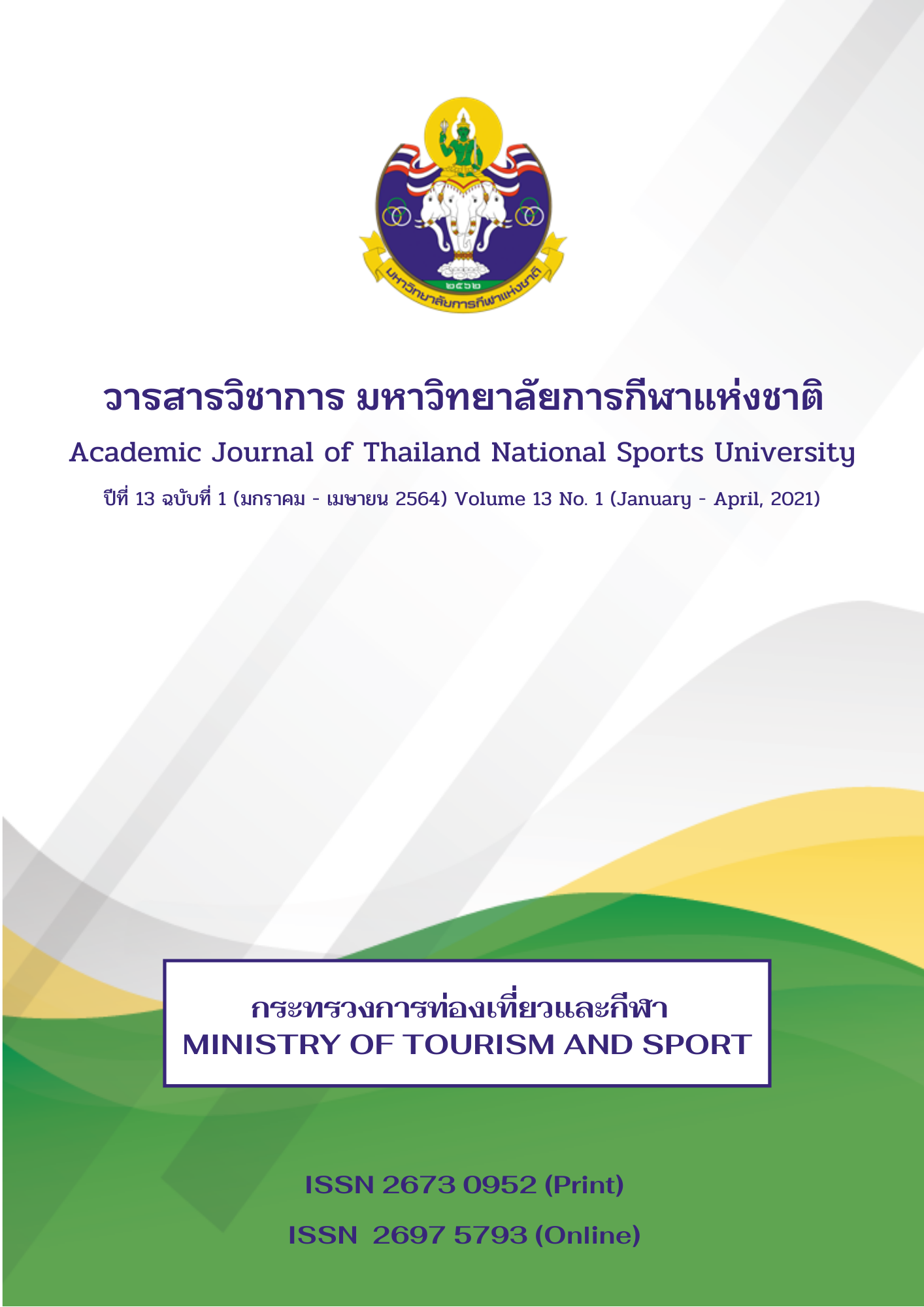CONSTRUCTIONAL MODEL OF MENTAL TRAINING PROGRAM
Main Article Content
Abstract
Conventional medicine has looked back the self-health care beyond medicine intake. Since, previous research reported a stress management with a mental training program resulting in that human’s physical biochemical is produced for self-healing (Kermani, 1992). In sports, athletes are those player who are stronger and more physically fit than ordinary people, nevertheless, their psychological part among before, during and after an important match can be naturally weak by the competitive situation (Bhasavanija, & Morris, 2013). Mental training was used for four functions; a cognitive or motivational function, and a general or specific level (Paivio, 1985). For instance, cognitive imagery use is to mentally perform exercises during injury for rehabilitation, and motivational imagery use is to manage goal setting, mental toughness, concentration, and positive attitude, even pain (Driediger, Hall, & Callow, 2006). Finally, psychological strategies should be used together with physical activities by eligible practitioner to help athletes prevent, rehab, and return to sport (Ford, Ildefonso, Jones, & Arvinen-Barrow, 2017), and related to intrinsic motivation, self-efficacy, and performance in athletes (Sari, 2015).
Article Details
The published article is a copyright of the Academic Journal of Thailand National Sports University. The passage appeared in each article in this academic journal is a perspective of each author which is not related to the journal. Each author is required to be responsible for all components of his/her own article. If there are any mistakes, each author must be responsible for those mistakes on his/her own.
References
Bhasavanija, T., & Morris, T. (2013). Using imagery of warmth in competition on oxygen consumption and golf performance enhancement. Proceedings of the China International Congress in Sport Psychology. Beijing, China: ISSP.
Bhasavanija, T., & Morris, T. (2015). Muangthong United football players’ recovery from football matches using a warmth imagery intervention. Proceeding of The 1st Malaysian Sports Psychology Conference. Kota Bharu, Kelantan, Malaysia: MSPC.
Bhasavanija, T., Vongjaturapat, N., Morris, T., & Muangnapo, P. (2011). Imagery training to increase hand warmth in golfers. Proceedings of the Taiwan International Congress in Sport Psychology. Taipei, Taiwan: ASPASP.
Cox, R.H. (2002). Sport Psychology: Concepts and application (5th ed.). New York: The McGraw – Hill Companies, Inc.
Cumming, J.L. & Ste-Marie, D.M. (2001). The cognitive and motivational effects of imagery training: A matter of perspective. Sport Psychologist, 15(3), 276-288.
Driedger, M., Hall, C., & Callow, N. (2006). Imagery use by injured athletes: A qualitative analysis. Journal of Sports Sciences, 24(3), 261-171.
Ford, J.L., Ildefonso, K., Jones, M.L., & Arvinen-Barrow, M. (2017). Sport-related anxiety: Current insights. Open Access Journal of Sorts Medicine, 8, 205-212. Retrieved from www.ncbi.nlm.nih.gov/pmc/articles/PMC5667788
Kermani, K. (1992). Autogenic training: The effective way to conquer stress (2nd ed.). London: Thorsons.
Kosslyn, S.M. (2005). Mental imagery and the brain. Cognitive Neuropsychology, 22(3-4), 333-347.
Kosslyn, S.M., Ganis, G., & Thompson, W.L. (2001). Neural foundations of imagery. Nature Reviews Neuroscience, 2(9), 635-642.
Lovell, G. & Colllins, D. (2002). Electroencephalographic differences between high and low mental imagery ability when learning a novel motor skill. Journal of Human Movement Studies, 43(4), 269-295.
McKay, M.T., Fischer, I, & Dunn, B.R. (2002). Cognitive style and recall of text: An EEG analysis. Learning and Individual Differences, 14(1), 1-21.
Moran, A.P. (2004). Sport and exercise psychology. New York: Routledge.
Morris, T., Splittle, & Watt, A. (2005). Imagery in sport. New York: Routledge.
Paivio, A. (1985). In P.C. McCarthy (2009). Putting imagery to good affect: A case study among youth swimmers. Sport & Exercise Psychology Review, 5(1), 27-37.
Papaioannou & Hackfort. (2014). Routledge companion to sport and exercise psychology: Global perspectives and fundamental concepts. Padstow, Cornwall, Great Britain: Routldge, Taylor & Francis Group.
Parent, J. (2005). Zen golf: Mastering the mental game. Great Britain: Collins Willow.
Sari, I. (2015). An investigation of imagery, intrinsic motivation, self-efficacy, and performance in athletes. Journal of Anthropologist, 20(3), 675-688. Retrieved from https://www.researchgate.net/publication/288439598_An_Investiga_tion_of_Imagery_Intrinsic_Motivation_Self-efficacy_and_Performance_in_Athletes
Smith, D. & Holmes, P. (2004). The effect of imagery modality on golf putting performance. Journal of Sport & Exercise Psychology, 26(3), 385-395.
Thammatipo, T. (2004). Mental depth causing unconsciousness. Bangkok: Mental Development Centre, Education Ministry of Thailand.
Tirata Bhasavanija. (2013). PED4303 Sport Psychology [Booklet]. Ramkhamhaeng University.
Tirata Bhasavanija. (2016). PED4303 Sport Psychology (1st ed.). Bangkok: Ramkhamhaeng University Press.
Tirata Bhasavanija, Jessada Jearanai, Dejsak Jantarasawat, & Arrisa Nitithum. (2004). An attention control training program for beginning golfer (Master’s thesis), Kasetsart University.
Utchara Chuerchang, Vongjaturapat, N., Sureeporn Anusasnanun, & Tirata Bhasavanija. (2019). Imagery training program on movement perception, short game performance and muscle electrical wave. Academic Journal of Physical Education Institute, 12(3).


